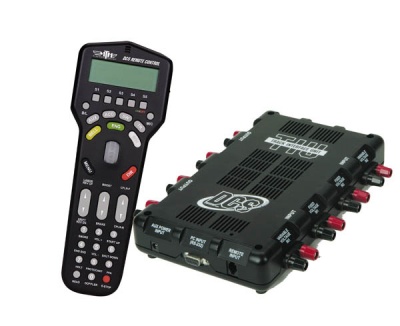Remote Control for Garden Trains
FOR GARDEN RAILWAYS
R/C PUTS YOU IN THE DRIVER'S SEAT
A remote control device for train operations. Photo by MTH Many hobbyists are familiar with single-purpose Remote Control or R/C planes, cars, helicopters, or drones. Remote control works the same way on a garden railroad layout. The controller sends messages such as stop/start, forward/backward, sound/silence to the train, and the train does as it is told.
WHY YOU MIGHT CHOOSE R/C
There are many reasons why some garden railway enthusiasts choose remote control over track power or automated battery operations. The following ideas are based on those outlined by Tom Farin in his online blog about R/C conversions at MyLargeScale.com>:
You really don't like to clean track. On a long length of track it is technically challenging to maintain electrical continuity and deal with voltage drop. You enjoy learning about electrical and mechanical work, taking engines apart, making modifications, and putting them back together. You have received technical training in electrical work, and your knowledge is such that doing a battery conversion is within your skill range. You like the idea of being able to walk around with your trains, controlling them with radio control.
WHY YOU MIGHT NOT CHOOSE R/C
Remote control is a lot of fun, especially if you have always wanted to be a train engineer, but it is not the only way to run trains, and it is not the best way for everyone. The biggest drawbacks to remote control are operator issues and battery life.
Operator issues mean that someone needs to tend the train -- if it is not also equipped with an automatic back-up system -- and if you are called away from the layout and don't have a trained second-in-command to run the trains, they must be stopped, even if you have visitors on site. Additionally, if two people each put their one remotely-controlled trains on the same track, and they are not skilled or paying attention, the trains can run into or up behind one another and cause a wreck, just like in real life.
R/C systems run on batteries, usually Litium-Ion batteries, and it is customary for garden railroad enthusiasts to conceal the batteries somewhere on the train. Due to space limitations in our locomotives, the batteries are usually hidden in the tender (the car carrying a load of coal or wood, right behind the locomotive) or in a boxcar near the front of the train. The main problem with batteries is that they have a limited run-time, so you will need a charger and back-ups if you plan to run trains more than a few hours, and after a while they do wear out and stop taking a charge, which means that you will have to dispose of them as hazardous waste.
SPECIAL EFFECTS WITH R/C
In addition to powering trains, remote control can also be used on a track-powered garden train to operate special effects -- and this is the way many garden railroaders like to use it most of all.
With R/C controllers you can surprise your guests with an explosion in a mine-shaft, a cannon firing, or a hot air baloon ascension. The R/C controller system lets you send a variety of equipment into action independently of the trains on a spontaneous basis.
